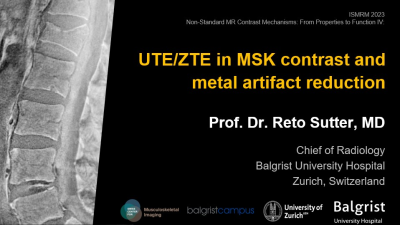Sunrise Course
Non-Standard MR Contrast Mechanisms: From Properties to Function IV: Short & Sweet: UTE & ZTE
ISMRM & ISMRT Annual Meeting & Exhibition • 03-08 June 2023 • Toronto, ON, Canada

| 07:00 |
Short & Sweet: UTE & ZTE: Theory
Emil Ljungberg
Keywords: Physics & Engineering: Pulse design Ultra-short or zero echo time (UTE and ZTE) enables MR contrasts that are not possible with conventional methods. In this presentation, you will learn how to achieve an echo time of near zero, the obstacles that must be tackled along the way, and about substances with ultra-short T2. This will set the stage for examples of novel images that cannot be acquired any other way. |
|
| 07:30 |
 |
Short & Sweet: Case Study & Applications of UTE/ZTE in MSK
Contrast/Metal Artifact Reduction
Reto Sutter
Keywords: Musculoskeletal: Skeletal, Musculoskeletal: Tendons Ultra-Short Echo Time (UTE) and Zero Echo Time (ZTE) imaging are two advanced techniques that have been increasingly applied in musculoskeletal imaging for visualization of tissues with short T2 relaxation times. ZTE imaging has been used primarily for the assessment of various osseous pathologies including fractures, osteolysis and degenerative changes. UTE imaging was used to assess a variety of bone, cartilage, and tendon pathologies. UTE/ZTE imaging also allows for quantitative assessment of short T2 tissues, providing information about tissue properties such as T2* relaxation times and collagen content making them valuable tools for the diagnosis and monitoring of musculoskeletal disorders.Ultra-Short Echo Time (UTE) and Zero Echo Time (ZTE) imaging are two advanced techniques that have been increasingly applied in musculoskeletal imaging for visualization of tissues with short T2 relaxation times. ZTE imaging has been used primarily for the assessment of various osseous pathologies including fractures, osteolysis and degenerative changes. UTE imaging was used to assess a variety of bone, cartilage, and tendon pathologies. UTE/ZTE imaging also allows for quantitative assessment of short T2 tissues, providing information about tissue properties such as T2* relaxation times and collagen content making them valuable tools for the diagnosis and monitoring of musculoskeletal disorders. |
The International Society for Magnetic Resonance in Medicine is accredited by the Accreditation Council for Continuing Medical Education to provide continuing medical education for physicians.